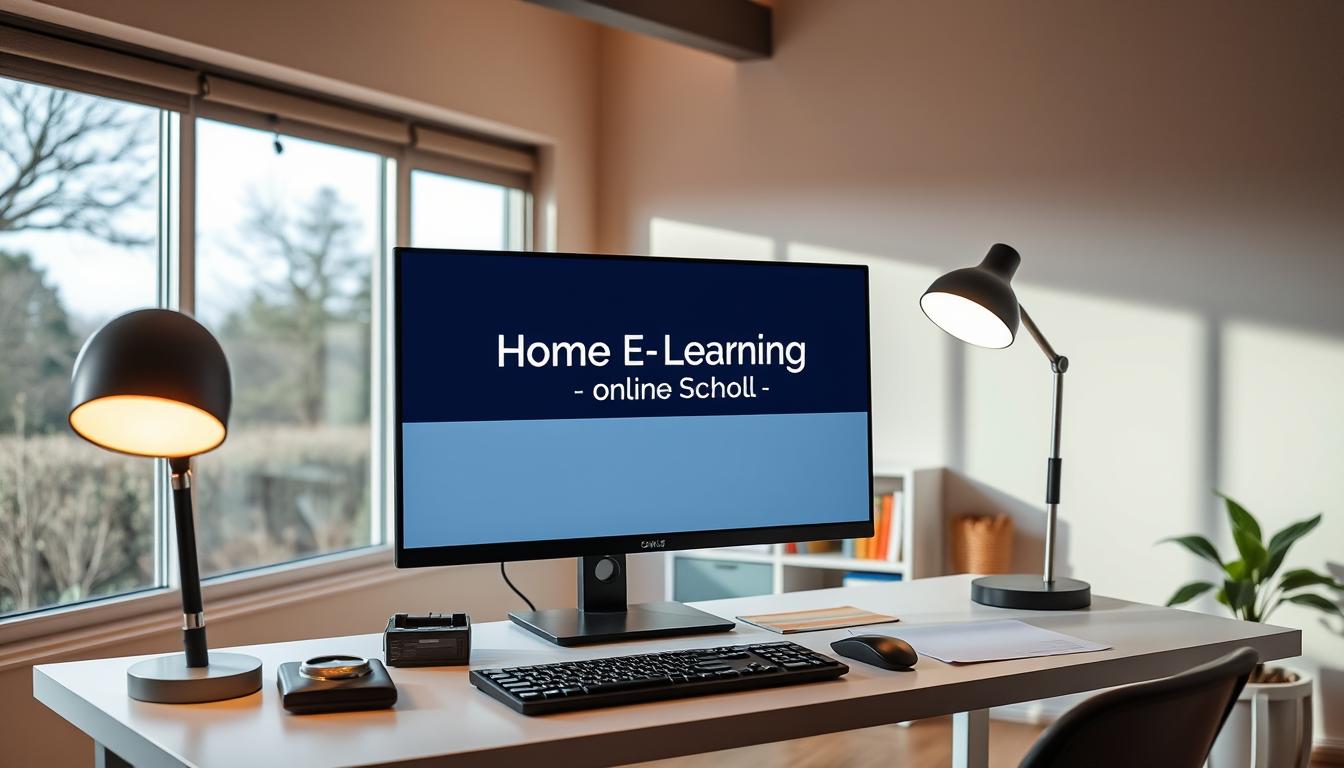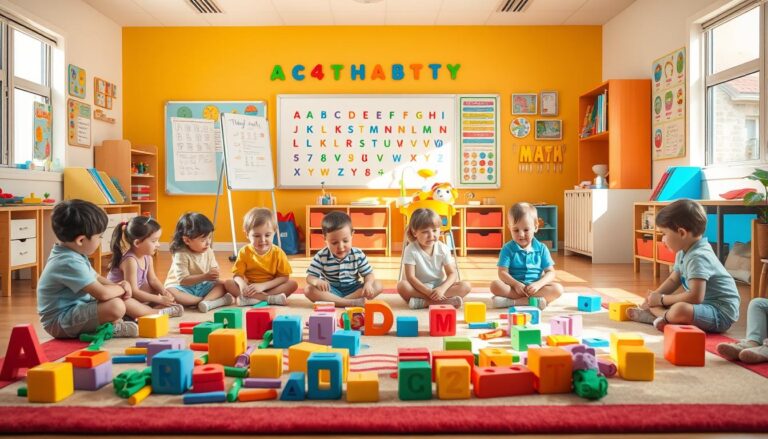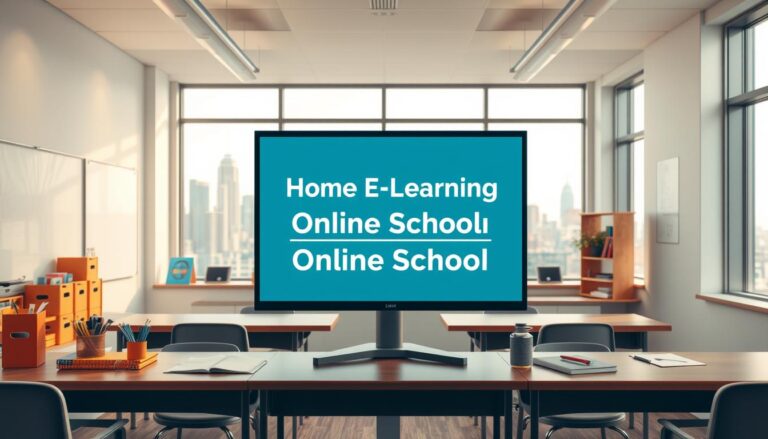Setting Up a Productive Online Learning Area
Did you know that a well-designed study space can boost your productivity by up to 25%? Creating a dedicated online learning environment is crucial for success in today’s digital classrooms. A thoughtfully organized space not only enhances focus but also fosters a sense of connection between students and educators, making the learning experience more engaging and effective.
At the heart of a productive learning area is comfort and functionality. Comfortable furniture and proper lighting are essential, as they contribute to a peaceful atmosphere that promotes concentration. By establishing a dedicated study space, you can clearly separate work from relaxation, which is vital for maintaining a healthy balance and improving your overall learning experience.
A well-organized study area reflects more than just physical comfort; it also supports academic success. Thoughtful design elements, such as a quiet room with minimal distractions, can significantly enhance your ability to stay focused. Additionally, incorporating motivational tips and tools, like a vision board or a whiteboard for planning, can transform your study space into a hub of productivity and inspiration.
Creating a supportive learning environment is not just about the physical setup; it’s also about the routines and systems you put in place. Whether it’s setting a consistent study schedule or ensuring your space is equipped with the right resources, every detail matters.
Crafting Your Ideal Study Environment
Creating a study environment that fosters focus and productivity is essential for academic success. A well-thought-out space can significantly enhance your learning experience, helping you stay concentrated and motivated throughout the day.
Choosing the Right Location
The first step in crafting your ideal study environment is selecting a quiet and distraction-free area. A room with minimal household noise allows you to stay focused during study sessions. If a dedicated room isn’t available, consider using noise-canceling headphones to create a peaceful atmosphere.
Investing in Comfortable Furniture
Comfort is key to maintaining focus. Invest in ergonomic furniture, such as a chair with proper lumbar support, to promote good posture. Ensure your desk is at a comfortable height to avoid strain on your neck and wrists.
Ensuring Adequate Lighting and Minimizing Distractions
Proper lighting is crucial for reducing eye strain. Natural light is ideal, but if unavailable, use warm desk lamps to create a calming environment. Keep your study area clutter-free and avoid distractions like smartphones. For more tips on designing an effective study space, visit our guide on online learning environments.
Designing a Supportive Online Learning Area
A well-organized study area is more than just a physical space; it’s a cornerstone of academic success. By thoughtfully structuring your environment, you can enhance focus, reduce stress, and create a balanced learning experience.
Organizing Materials for Efficiency
Keeping your study materials in order is key to staying productive. Use shelves or storage bins to keep everything within easy reach. Labels can help you quickly find what you need, saving time during study sessions. Digital tools, like assignment trackers, can also streamline your routine and keep you organized.
Creating Distinct Zones for Study and Breaks
Dividing your space into work and relaxation areas helps maintain a healthy balance. Designate a specific zone for studying and another for breaks. Adding plants or using calming colors can make these areas more inviting. This separation supports mental well-being and keeps you focused when it’s time to work.
A supportive online learning area should reduce stress and promote efficiency. By organizing your materials and creating distinct zones, you can enhance your academic experience. These practices not only boost productivity but also contribute to overall well-being.
Setting Up an Effective Learning Space for Online Students
Creating a structured environment is key to academic success, especially for online students. A well-organized space helps maintain focus and discipline, which are crucial for effective learning.
Establishing a Consistent Routine
A daily routine provides a sense of stability and helps students stay on track. By setting specific times for study and breaks, you can create a balanced schedule that supports both productivity and relaxation. This routine also helps in reducing procrastination and ensures that all tasks are completed efficiently.
Balancing Work and Rest for Success
Maintaining a balance between study and leisure is vital for long-term success. Incorporating regular breaks, such as using the Pomodoro technique, can enhance focus and prevent burnout. This balance not only improves mental well-being but also ensures that students can sustain their academic efforts without feeling overwhelmed.
By establishing a consistent routine and balancing work with rest, online students can create a supportive learning environment that fosters success and personal growth. These strategies not only enhance academic performance but also contribute to overall well-being, making the learning experience more enjoyable and productive.
Enhancing Engagement Through Interactive Tools
Interactive tools play a vital role in making online learning experiences more engaging and effective. By integrating multimedia elements, educators can cater to diverse learning styles, ensuring that every student stays involved and motivated.
Incorporating Videos and Gamified Content
Videos are powerful tools for transforming traditional lessons into dynamic experiences. Platforms like Khan Academy have shown that animation videos can simplify complex concepts, making them easier to understand. Gamified content, such as interactive quizzes and puzzles from platforms like Storyline, adds a fun element to learning. These activities keep students actively involved and excited about their lessons.
Fostering Active Communication and Feedback
Effective communication is key to a successful online learning experience. Tools that enable real-time discussions and prompt feedback help students feel supported. Discussion forums and video conferencing features allow learners to connect with educators and peers, fostering a sense of community. Timely feedback, in particular, helps students track their progress and stay motivated.
Interactive tools not only boost engagement but also cater to different learning styles. For instance, speech-to-text functionality and real-time translation services make learning accessible to a broader audience. These features create an inclusive environment where every student can thrive.
By blending teaching with interactive elements, educators can create a smooth and enjoyable learning experience. Feedback and active participation reinforce students’ confidence and strengthen their identity as learners. These strategies ensure that online learning is not just effective but also empowering.
Leveraging Digital Tools for Seamless Class Management
Digital tools have revolutionized the way we manage online classes, making it easier for teachers and students to stay connected and organized. These tools not only streamline daily tasks but also enhance the overall learning experience, creating a more efficient and engaging environment for everyone involved.
Choosing the Right Learning Management System
Selecting a robust Learning Management System (LMS) is the first step in creating a seamless online learning experience. Platforms like Moodle or Canvas offer comprehensive solutions for organizing course materials, tracking student progress, and facilitating communication. These systems allow teachers to upload resources, assign tasks, and monitor student performance in a centralized environment, making it easier to manage the classroom effectively.
Streamlining Instructor-Student Communication
Effective communication is the backbone of any successful online learning experience. Tools like Zoom or Microsoft Teams enable real-time interactions, allowing teachers to hold virtual meetings, provide instant feedback, and address student queries promptly. Additionally, platforms like Kahoot! and Quizlet offer interactive features that make learning fun and engaging, while also providing valuable insights into student performance.
By leveraging these digital tools, educators can create a structured and supportive online learning environment. These platforms not only save time but also ensure that the learning process remains smooth and efficient throughout the day. Whether it’s managing resources, communicating with students, or tracking progress, the right digital tools can make all the difference in fostering a positive and productive online learning experience.
Personalizing Your Space for Maximum Productivity
Transforming your study area into a reflection of your personality can significantly boost your productivity. A personalized space not only makes learning more enjoyable but also creates a sense of ownership and motivation.
Infusing Personal Touches and Motivational Elements
Add personal touches like inspiring quotes, artwork, or plants to create a nurturing atmosphere. These elements can enhance creativity and reduce stress, making your study sessions more effective.
- Incorporate items that reflect your passions to make the space uniquely yours.
- Use motivational quotes or vision boards to stay focused on your goals.
- Plants can improve air quality and uplift your mood, creating a calming environment.
Blend functionality with personality by mixing digital tools with traditional resources. This approach keeps your space organized and visually appealing. A personalized area helps minimize distractions, reinforcing your connection to the space and making study sessions more focused.
Adapt your décor and layout as your study needs evolve. This continual process supports academic success and personal well-being. Remember, a space that feels like your own invites productivity and makes learning a more enjoyable experience.
Conclusion
In conclusion, crafting a productive online learning environment is a blend of intentional design, balance, and innovation. By integrating digital tools, personal touches, and consistent routines, you can transform your study area into a dynamic hub that fosters engagement and success. Remember, balance is key—regular breaks and clear boundaries between study and rest are vital for long-term success and well-being.
Interactive tools and organized class management can elevate your space, making learning more enjoyable and effective. We encourage you to apply these tips and tailor them to your unique needs. Investing time in creating a supportive space directly impacts your online learning experience and success.
Visit our guide again for more insights and share your own stories of creating an engaging learning environment. Together, we can empower every student to thrive in their educational journey.







